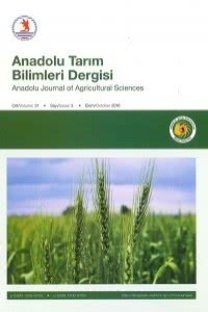Broiler üretiminde farklı ışık kaynakları ve aydınlatma sürelerinin verim özelliklerine etkiler
Bu çalışmada broiler üretiminde ışık kaynakları (akkor telli ampul, floresan ampul ve ekonomik floresan ampul) ve aydınlatma programlarının (sürekli ve kesikli) etkilen araştırılmıştır. Beş farklı muamelenin (1:akkor telli lamba ile sürekli aydınlatma, 2:akkor telli lamba ile kesikli aydınlatma 1A+1K, 3: floresan lamba ile sürekli aydınlatma, 4: floresan lamba ile kesikli aydınlatma 1A+1K, 5: ekonomik floresan lamba ile sürekli aydınlatma) ölüm oranı, yem tüketimi, yemden yararlanma oranı, verim indeksi, canlı ağırlık ve karkas özellikleri üzerindeki etkileri araştırılmıştır. Ayrıca cinsiyete bağlı farklılıklar incelenmiş, muameleler arasında ekonomik açıdan mukayese yapılmış, en karlı uygulama belirlenmeye çalışılmıştır. Deneme sonuçlarına göre; 1., 2., 3., 4., ve 5. hafta canlı ağırlıkları, yem tüketimi, yemden yararlanma oranı (1.88, 1.98, 1.98, 1.74 ve 1.94), verim indeksi, yaşama gücü (%92.5, %94.2, %95.8, %92.5 ve %95.8), karaciğer ve taşlık ağırlığı bakımından muameleler arasındaki farklılıklar önemli çıkmamıştır. Kesim yaşı (6. hafta) canlı ağırlığı (2111.7, 2060.3, 1986.7, 1971.7 ve 2035.0 g), karkas ağırlığı (1560.99, 1518.20, 1454.46, 1462.52 ve 1501.77 g) ve kalp ağırlığı açısından oluşan farklılıklar ise önemli bulunmuştur (PO.05). Kesim randımanı dışında kalan bütün özelliklerde cinsiyet farklılıkları önemli olmuştur (P
Anahtar Kelimeler:
etlik piliç performansı, karkas verimi, yemden yararlanma, yem alımı, yaş, vücut ağırlığı, ışık rejimi, ölüm oranı, organlar, kümes hayvanları, cinsiyet farklılıkları, etlik piliç
The effects of different light sources and lighthing periods on the broiler performances in poultry houses with windows
This study was conducted to compare the sources (incandescent, flourescent and economical flourescent lamp) and lighthing methods (continious and intermittent). The effects of five treatments (1 :continious lighthing with incandescent lamps, 2 intermittent lighthingwith incandescent lamps 1L+1D, 3:continious lighthing with flourescent lamps, 4:intermittent lighthing with flourescent lamps, 5:continious lighthing with economical flourescent lamps) on mortality, feed consumption, feed conversion, production index, live body weight and carcass traits in broilers were studied. Treatments were compared for net benefit. In addition, sex effects were determined. The results indicated that there were no significant differences between the live body weight at 1., 2., 3., 4., and 5., weeks, feed consumption, feed conversion (1.88, 1.98, 1.98, 1.74 ve 1.94 for the treatment group respectively), production index, viabilities (92.5%, 94.2%, 95.8%, 92.5% and 95%, respectively), weight of liver and gizzard. The differences between the treatments for the live body weight at 6th week (2111.7, 2060.3,1986.7, 1971.7 ve 2035.0g, respectively), and carcass yield (1560.99, 1518.20, 1454.46, 1462.52 ve 1501.77 g, respectively) and heart weight were statistically significant (P<0.05). Sex was an important factor in terms of all criteria except carcass yield. The continious lighting with incandescent lamp was the most economical treatment. But, the continuous lighting with the economical flourescent and intermittent lighting with the flourescent more economic than the other lighting procedures the economical criteria.
Keywords:
broiler performance, carcass yield, feed conversion efficiency, feed intake, age, body weight, light regime, mortality, organs, poultry, sex differences, broilers,
___
- ISSN: 1300-2988
- Yayın Aralığı: Yılda 3 Sayı
- Başlangıç: 2018
Sayıdaki Diğer Makaleler
Biçim zamanı ve kurutma methodunun kuru otun yem değeri üzerine etkisi
Türlerarası melezlerde kromozom eşleşmesinin genetik kontrolü
İbrahim MANGA, ZEKİ ACAR, İlknur AYAN, İSKENDER TİRYAKİ, M.Arif ÖZYAZICI
Allo ve autotetraploidlerde kromozom eşleşmesinin analizi
Değişik hammaddelerden boza üretimi ve üretilen bozaların bileşimi
